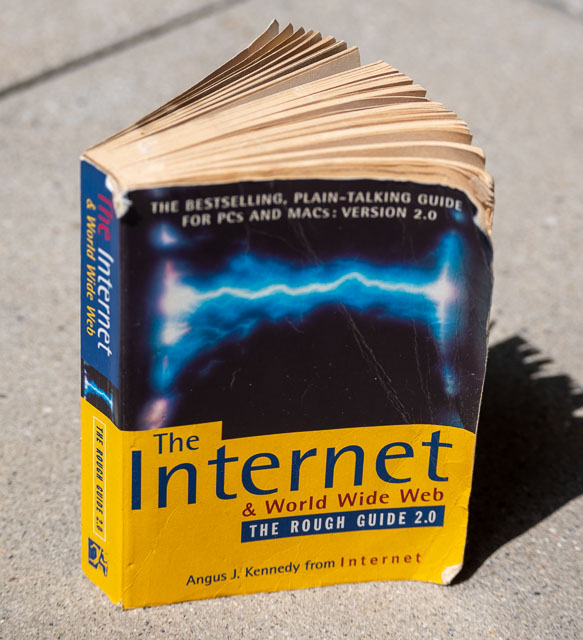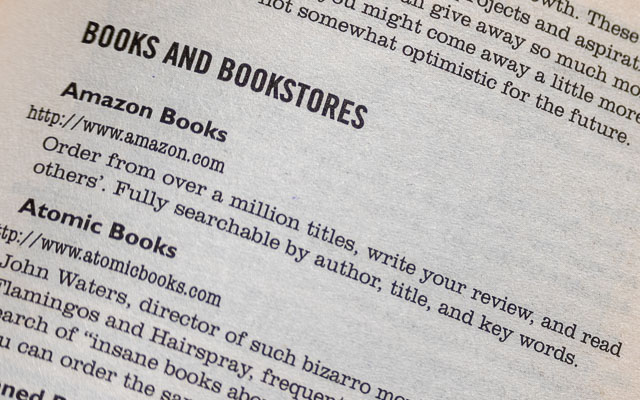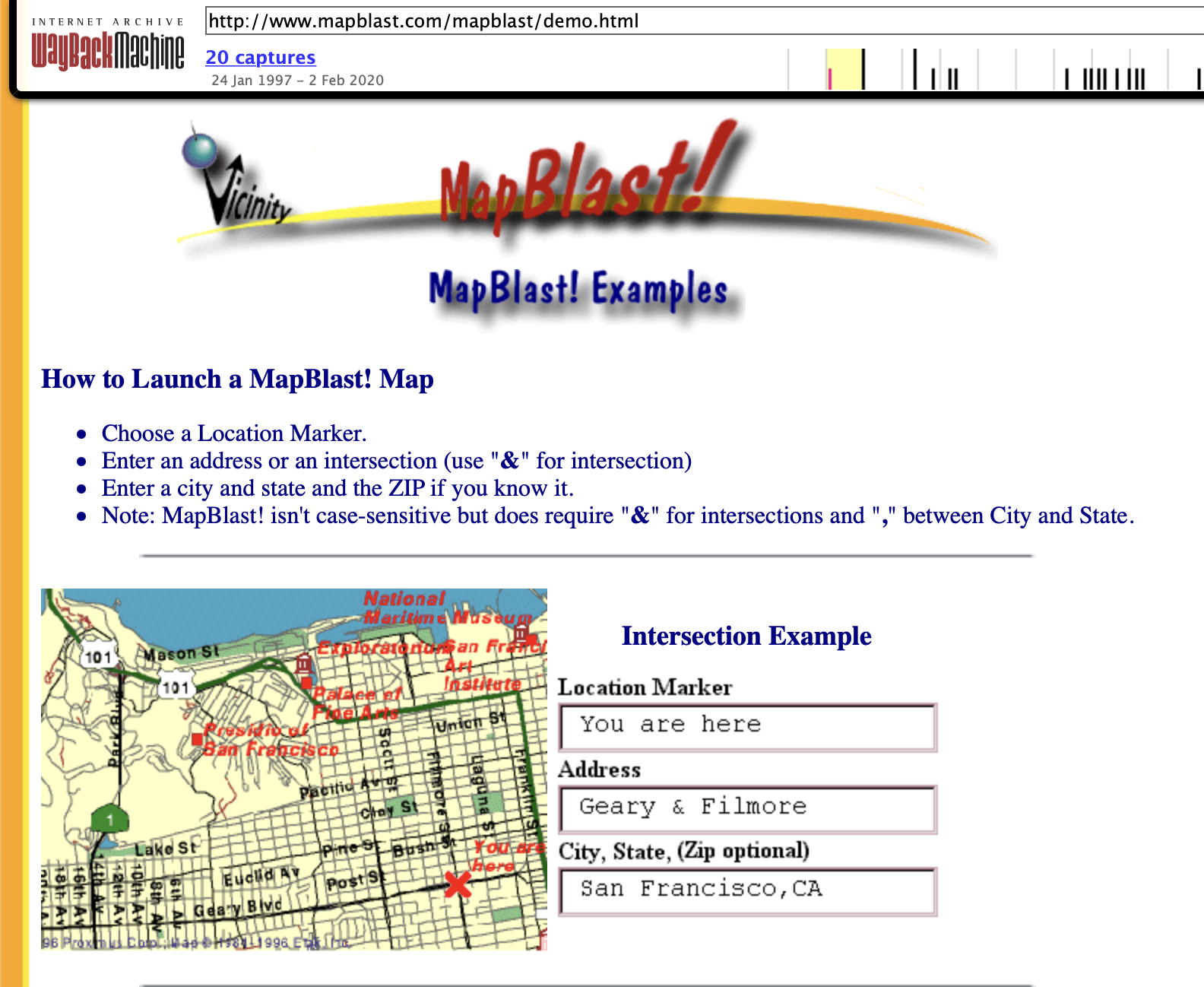A trip to the internet in 1996 with The Rough Guide 2.0
Saturday, June 10, 2023
Prepare to be transported back in time as I delve into one of my all-time favorite books from my teenage years: The Rough Guide 2.0: The Internet & World Wide Web. This brilliant pocket-sized book had me hooked. In the 1990s I read it cover to cover and I have read it one more time to produce this post - a journey back to how the internet was 27 years ago.
Whether it’s the speed or permanence of our connections, the devices we use to access the internet, the birth of social media, the boom of e-commerce, the surge of online advertising… I found it frighteningly fascinating to reflect on where we were just a few years before the millenium.
Getting online in 1996
A 14,400 bps modem was considered entry level, but if you “could afford it” a 28,800 bps (upgradeable to 33,600 bps) modem was preferable. My first modem was 33,600 bps which (on a good day) gave speeds of 4.2 Kilobytes per second. This post is being written using a cable connection which has a maximum speed of 1 Gigabit per second (so 125 Megabtyes per second). That’s almost 30,000 times faster than the cutting edge 27 years ago.
The Rough Guide 2.0 briefly mentions the future by tempting the possibility of always-on connections from your cable TV provider or ADSL - but these technologies seemed liked a pipedream in 1996. The reality of my childhood was only using the internet at weekends or after 6pm midweek, when calls were cheaper. The Rough Guide advises you only use an Internet Service Provider (ISP) that provides access through a local telephone number, to minimise the call charges. It’s unthinkable now but I used to pay a monthly subscription to my ISP and, in addition, the call costs.
CompuServe and AOL feature are named as the largest ISPs. I think CompuServe (because their free trial CDs were everywhere) were my first ISP, but the number they gave you instead of a proper username was too weird for my liking, so I didn’t stay with them for long.
The Hardware and Software
This was the age of waking up early on a Sunday morning (for those cheap calls!) to download the new release of Internet Explorer or Netscape Navigator. The Rough Guide 2.0 states you’ll need a PC with at least a 486 DX33 processor and 8MB of RAM to surf the internet (or Macintosh equivalent). My first access to the internet came via my first PC - a Pentium 75 running Windows 95 . The books only mention of the internet on a mobile phone is the Nokia 9000, which let’s face it did not look an attractive experience irrespective of the year.
The Rough Guide 2.0 in 1996 still advocates for Netscape Navigator with it described as the industry leader. I think 1996 was as good as it got for Netscape, with market share declining in every subsequent year. The Rough Guide 2.0 predicts this somewhat by saying "Although at the time of writing, Netscape is still the superior browser, it could well be overtaken". Personally I remember many sites saying "This site is best viewed in Netscape" or "This site is best viewed in Internet Explorer". The Rough Guide is really all about Netscape Navigator and Internet Explorer, but Oracle's Power Browser gets a mention, as does Mosaic. Both did not last long.
One of the striking things is how much of the book is dedicated to FTP. Nowadays everything is downloaded over HTTP, but in 1996 The Rough Guide states "Before you can download anything you'll need an FTP (File Transfer Protocol) Program". It is also very striking how there is no mention of SSL, TLS or HTTPS in the entire book; none of which were really invented in 1996.
An age without social media
An obvious black hole in The Rough Guide 2.0 is the complete lack of any commercial social networks. There's no MySpace, no Facebook, no Twitter, no Instagram, no Snapchat, no Whatsapp. None of these had been invented. Instead to communicate with others and form what we know today as a “social network” the following are suggested:
Internet Relay Chat (IRC)
“There’s a facet of the Internet that is often described as the online equivalent of CB radio” is how The Rough Guide describes it. In a sign of how IRC's popularity has waned, Discord (commercial software) is what most people would class as the modern day equivalent of IRC. And most people’s interactions with chatrooms, bots and commands has, and always will be, via Discord not IRC.
Newsgroups
The Rough Guide makes them sound better than Chat GPT today e.g. “Want to know the recipe for Lard Surprise, whether it’s safe to go to Kashmir, why Quake keeps crashing, or where to sell that unexploded land mine in your garden? Fine, just find the right Newsgroup…”. Newsgroups were essentially a decentralized form of social network, where your news provider (usually your ISP) synchronized the latest messages to its local copy. Personally I remember using them and finding interesting content, but also struggling with the sheer amount of spam. Dejanews.com was a web based archive of newsgroup posts which existed in 1996. Unfortunately Google’s acquisition and rebranding of it to groups.google.com became progressively and painfully worse. When writing this article I tried to use groups.google.com but I couldn’t find anything. What a shame.
Mailing Lists
E-mail has not only survived, but flourished in the 27 years since The Rough Guide 2.0 was published. A key suggestion for receiving information and participating in discussions in the book is to join a mailing list (running via LISTSERV or MajorDomo). To find suitable mailing lists sites like InReference and Liszt are recommended; but unsurprisingly none of them exist today.
Online Gaming
The other form of social interaction was via “online” games like Command & Conquer and Duke Nukem 3D. These were tremendous fun but in 1996 they were not played over the internet. First I had to co-ordinate with my friend and then dial their home telephone number for his modem to answer. Hardly internet gaming as we know it today. Though The Rough Guide 2.0 was prophetical when saying “Many say the Internet’s next ‘killer applications’ will be inspired by networkable PC games”.
Like most people in 1996 I used the e-mail address that came with my ISP. Nowadays I couldn’t care less if my cable provider provides e-mail accounts or not. My e-mail client of choice in 1996 was Microsoft Internet Mail and News. The “and news” part reflects how much prominence newsgroups had - so much that they were fully integrated into your Windows e-mail client. The Rough Guide 2.0 recommends Eudora's commercial version and says those who use it swear by it. Webmail was not ubiquitous but Hotmail (which launched in 1996 and is now Outlook.com) is mentioned. So The Rough Guide captures the early days of web based e-mail which will come to be dominated by Google, Yahoo and Microsoft via their hotmail.com acquisition. Interestingly The Rough Guide splits Hot and Mail into two separate words: "Our pick is Hot Mail at http://www.hotmail.com. Just log into the Web page, give a few details and you’ll have a mail account in seconds".
Another striking aspect is that an e-mail address (not your Twitter handle or mobile number) was your identity on the internet in 1996. This is reinforced by The Rough Guide pointing the reader to directories like Four11 (acquired by Yahoo in 1997 for its web mail), Bigfoot (closed during the dot-com crash) and WhoWhere (no longer operational) to try and find someone’s e-mail address.
Search
Google wasn’t invented until 1998, so it does not feature at all. In 1996 the Rough Guide 2.0 suggests you find information using:
- www.altavista.com: this was my favourite, but I remember frustration creeping in as the amount of spam results increased. It was acquired by Yahoo and eventually redirected to Yahoo Search
- www.lycos.com - I was very surprised to see it still exists today, albeit a shadow of its former self and a shadow of its former huge valuation during the dot-com bubble
- www.infoseek.con - acquired by Disney. I remember using this as a backup search engine if the results from AltaVista weren't good enough
The Yahoo directory is listed as being “Indispensable”. Personally I never found it that way, but because everyone else seemed to know something I didn't, I tried to get my personal website listed - but despite filling out the arduous submission form it was to no avail. The Yahoo Directory was eventually retired at the end of 2014. Again, personally, I did not miss it.
There is also no mention of Wikipedia, which wasn’t founded until the year 2000.
E-Commerce

Amazon Books appears under the Books and Bookstores category in The Rough Guide's Web Sites Directory. That is its only mention. Two more years would pass before Amazon moved beyond books and on its journey to the behemoth it is today. Instead, the megastore in 1996 was CDnow! described by The Rough Guide 2.0 as “everything you’ve ever wanted from an entertainment megastore’. I guess CDnow was one of the internet’s first unicorns; but after its operations were outsourced to Amazon it eventually disappeared completely 10 years ago.
digicash.com is listed as “one of the frontrunners in the race to develop an acceptable “smart” currency for Net transactions”. It never gained traction.
At its rear The Rough Guide 2.0 states what is holding back e-commerce in 1996: “Net commerce awaits browsers that can talk to commerce servers using totally snooper-proof encryption. That technology has been available for use within the USA for years, but until restrictions are lifted, online business will continue to flounder. With big shots like Microsoft’s Bill Gates lobbying Congress, it can only be a matter of time before bans are lifted and digital trading gets the green light.” This was alluding to the Crypto Wars and some strange events like Netscape developing two versions of its browser with export and domestic grade levels of encryption.
Worth noting is that despite occasional mentions of newsgroup spam, there is nothing noteworthy in The Rough Guide 2.0 regarding internet advertising and tracking. The term paywall also doesn’t feature - according to my Googling the first paywall would appear one year later thanks to the Wall Street Journal. Also absent is the mention of any auction sites like eBay - though it did open for business in September 1996, so I am sure it was included in the next edition of The Rough Guide.
Maps

This post seems to be listing more things that didn’t exist in 1996 than things that did. Good online mapping services are another example. Now we have satellite imagery, streetview, etc. In 1996 mapblast.com which now redirects to Bing was one of the few available services. As you can see from the screenshot courtesy of the Internet Archive's Wayback Machine mapping technology has come a long way. In 1996 you could slowly download a barely legible static image of your map. I also think the coverage was very much USA focused.
The ‘Creating your own web page’ chapter
This is the section I feel most nostalgic and sad about. In 1996 it felt like the possibilities were endless and anyone with a text editor and some space that your ISP provided could, and often would, have their own homepage. And lots of people did. Some other people used geocities. It’s actually much easier and cheaper to have your own homepage now then it was in 1996. What someone can build from their bedroom today is phenomenal and its easy and affordable to get your own domain name. But there was something about the internet in 1996 which felt like the barriers to entry were lower and the possibility to get recognised and gain traction for your creation felt higher.
Reading this section I was surprised to see no mention of CSS. CSS wasn’t invented until December 1996 and didn’t become relatively common until a few years later. All the styling examples in The Rough Guide 2.0 embed the styling in the HTML e.g. <BODY BGCOLOR="#00E4FF" or <FONT SIZE ="5">.
Java Script (two words), ActiveX, Java, PERL and CGI are briefly mentioned. And one trick The Rough Guide 2.0 shares with budding web developers is “If you see something you like… ask the Webmaster”. I am not sure how successful this would have been in 1996, but even finding an e-mail address someone would read and reply to would be a struggle nowadays.
No post about the internet of old could fail to mention geocities.com. There were so many interesting and strange looking creations hosted there. It features in the directory of The Rough Guide 2.0: "Build your own free “homestead” in a virtual city that suits your style". Unfortunately the cities were destroyed when Yahoo, who had acquired it for billions during the dot-com bubble, decided to destroy them.
Search Engine Optimization clearly hadn’t reached its peak in 1996 but there was some advice to rank higher: “tricks like stringing repeated key words outside the HTML body, which can trick engines into prioritizing your page for that subject”.
And in an era without detailed analytics the way to see who was visiting your site was to add a hitcounter. The Rough Guide 2.0 recommends digits.com (which is today offering AI powered accounting software). For reference, here’s a nostalgic image of the hit counter from one of my old websites:

Software and websites still with us
Here are some of the websites and software in The Rough Guide 2.0 that are still with us today:
- www.imdb.com - the internet movie database is still an essential website and something I consult often to check the imdb rating. Now owned by Amazon.
- hjg.cso.uiuc.edu/PG/welcome.html was Project Gutenberg’s old address in 1996 - now it’s just a tad bigger at www.gutenberg.org
- Online dating had started in 1996 and www.match.com is the only one mentioned in The Rough Guide that is still standing
- www.medscape.com is still going strong today as a site for healthcae professionals. Even in 1996 it was aimed at health professionals and medical students and quickly built up its collection of articles
- The video gaming website www.gamespot.com had just started in 1996 and it is still going strong today. The Rough Guide also lists www.happypuppy.com, which no longer works today but in 1996 self-declared itself as The #1 Games Site on the Internet
- ACDsee was my favourite image catalogue and viewer back in the 1990s and it is mentioned in The Rough Guide 2.0 as an Extraordinarily fast graphics file viewer. The company and its image products still exist today at a much clearer domain than their original vvv.com:80/acd/
Software and Website Obituary
To conclude the post I have chosen some websites and software listed in the Rough Guide 2.0 which are no longer with us today:
- www.sun.com - described as "the Net's biggest hardware player". Unfortunately it all went wrong for Sun microsystems and it was acquired by Oracle in 2010
- In 1996 it felt like world wide web destinations were endless and walled gardens like facebook.com didn't exist. Cool Site Of the Day (cool.infi.net).com was the Reddit or Digg of its day - getting your site listed here could give your site enough traffic to break it
- Eudora was the recommended e-mail client in 1996, but it wouldn't last long with the commercial product discontinued and the open source version not gaining traction
- The Rough Guide described Microsoft's ActiveX as "a Web-centric programming environment more powerful than the much lauded Java, but without the same platform independence, and clearly geared toward progressing Microsoft's software dominance". Thankfully ActiveX finally died in 2015 and along with it the use of the
OBJECTtag for embedding plug-ins like this - Macromedia Shockwave received two stars in The Rough Guide's directory. After the acquisition by Adobe the technology was finally put to rest in 2019
- realaudio.com - today the domain name is for sale for 50,000 USD. In 1996 it was the software The Rough Guide told you to download first before listenting to internet radio. Ok so this one isn't really dead - it just rebranded to real.com
Of course the final obituary is The Rough Guide: The Internet & World Wide Web itself. Its website roughguides.com/net no longer exists and its last edition was , I believe, published in 2009. If you have interest in a summary of the 2009 edition let me know and I'll order a copy off eBay.